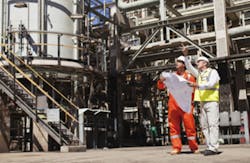The U.S. Department of Energy's Advanced Research Projects Agency-Energy (ARPA-E) announced in December $60 million in funding for 22 new projects aimed at detecting and measuring methane emissions and developing localized thermal management systems that reduce the energy needed to heat and cool buildings.
The projects are funded through ARPA-E’s two newest programs: Methane Observation Networks with Innovative Technology to Obtain Reductions (MONITOR) and Delivering Efficient Local Thermal Amenities (DELTA).
“These new projects highlight the Department of Energy’s commitment to developing a broad range of disruptive technologies to ensure a secure, affordable and sustainable American energy future,” said U.S. Energy Secretary Ernest Moniz, in an official announcement. “Investments in innovative methane detection and thermal management technologies demonstrate ARPA-E’s role in catalyzing energy research and development by leveraging our top scientists and engineers from across the country.”
Additional information on ARPA-E’s MONITOR and DELTA programs is included below. Details on all 22 projects may be found here.
Methane Observation Networks with Innovative Technology to Obtain Reductions (MONITOR) – $30 Million
ARPA-E’s MONITOR program focuses on reducing methane emissions associated with energy production. The program plans to provide $30 million to support 11 project teams in developing low-cost, highly sensitive systems that detect and measure methane associated with the production and transportation of oil and natural gas.
Example of a selected MONITOR project:
Bridger Photonics, Inc. | Bozeman, Mont. | Mobile LiDAR Sensors for Methane Leak Detection
Bridger Photonics will develop a light-detection and ranging (LiDAR) system capable of rapid and precise methane measurements resulting in 3D topographic information about potential leak locations. As described by the DOE, a novel near-infrared fiber laser will enable long range detection with high sensitivity and can be deployed on a range of mobile platforms to survey multiple sites per day. The DOE says this mobile LiDAR system will "dramatically reduce the cost to identify, quantify and locate methane leaks compared to currently available technologies."
Delivering Efficient Local Thermal Amenities (DELTA) – $30 Million
ARPA-E’s DELTA program will develop localized heating and cooling systems and devices to expand temperature ranges within buildings. The program plans to provide $30 million to support 11 project teams in developing technologies that can regulate temperatures focused on a building’s occupants and not the overall building. This localization of thermal management will enable buildings to operate in wider temperature ranges while still ensuring occupant comfort, which would dramatically reduce the building’s energy consumption and associated emissions, the DOE says.
Example of a selected DELTA project:
Syracuse University | Syracuse, N.Y. | Micro-Environmental Control System
Syracuse University will develop a near-range micro-environmental control system transforming the way office buildings are thermally conditioned to improve occupant comfort. The system leverages a high-efficiency micro-scroll compressor in a micro vapor compression system, whose evaporator is embedded in a phase-change material. This material will store the cooling produced by the micro vapor compression system at night, releasing it as a cool breeze to make occupants more comfortable during the day. This micro-environmental control system could save more than 15 percent of the energy provided for heating and cooling.


